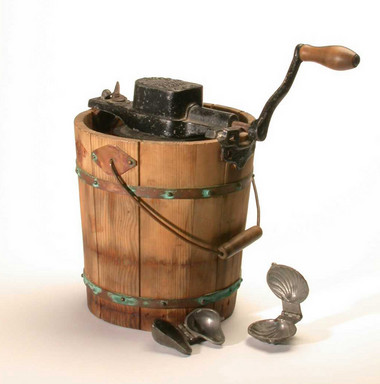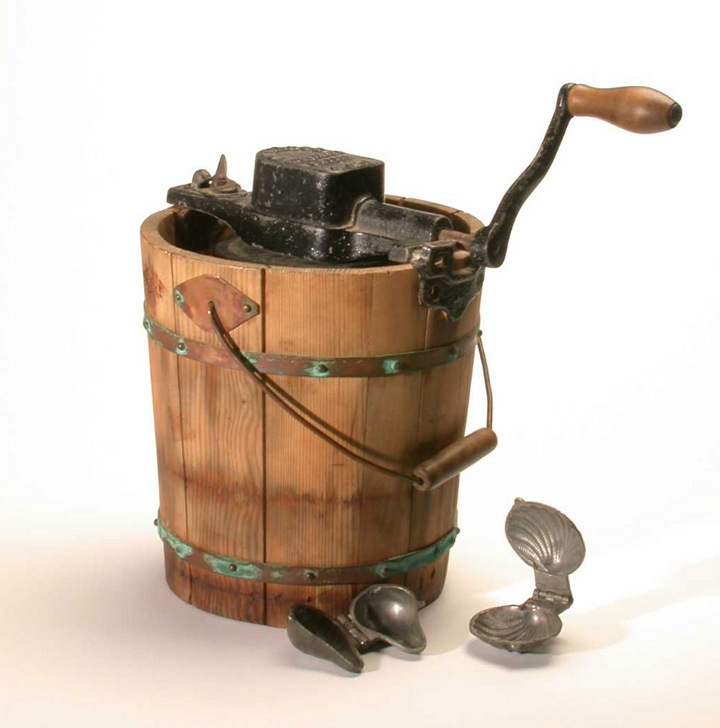Ice Cream Maker & Moulds, Victorian, Original
Ice cream might seem like a modern invention but in fact it has been around for many years. The first recorded serving of ice cream was to King Charles 2nd in 1672 at a banquet, although even on this occasion it was only served tot he King and his close acquaintances, everyone else present could only look on in envy. Ice cream was a luxury, eaten only by the wealthy. This was because ice was hard to keep. It was collected in the winter and stored in icehouses, which were often pits in the ground insulated with straw. By the second half of the 19th century ice-cream became a treat for ordinary people and the ice trade began, importing ice from the Balkans and Scandinavia.
The ice-cream maker shown here is a wooden tub, bound together with copper bands. The handle turns a set of wooden paddles set inside a metal cylinder. The section that holds the handle and the cogs to turn the paddles is made of cast iron. On the top are inscribed the name of the ice cream maker (The 'Reliance'), the place that it was made (Sweden) and the fact that it makes 2 quarts of ice cream. It was patented 1881-85.
Ice cream was made by pouring cream into the metal cylinder and filling the space between the cylinder and the bucket with ice and salt. Ice and salt react together to lower the temperature below freezing. The cream was moved around by turning the handle so that it froze evenly.
There are recipes for delicious Victorian ice-cream in many flavours, such as vanilla, raspberry and chocolate. The two hinged pewter moulds shown here would have been used to create fancy shaped ice cream portions.
The ice-cream maker shown here is a wooden tub, bound together with copper bands. The handle turns a set of wooden paddles set inside a metal cylinder. The section that holds the handle and the cogs to turn the paddles is made of cast iron. On the top are inscribed the name of the ice cream maker (The 'Reliance'), the place that it was made (Sweden) and the fact that it makes 2 quarts of ice cream. It was patented 1881-85.
Ice cream was made by pouring cream into the metal cylinder and filling the space between the cylinder and the bucket with ice and salt. Ice and salt react together to lower the temperature below freezing. The cream was moved around by turning the handle so that it froze evenly.
There are recipes for delicious Victorian ice-cream in many flavours, such as vanilla, raspberry and chocolate. The two hinged pewter moulds shown here would have been used to create fancy shaped ice cream portions.

Mould:Length:7cm Ice cream maker:Height:31cm

Mould:Length:7cm Ice cream maker:Height:31cm

Ice cream might seem like a modern invention but in fact it has been around for many years. The first recorded serving of ice cream was to King Charles 2nd in 1672 at a banquet, although even on this occasion it was only served tot he King and his close acquaintances, everyone else present could only look on in envy. Ice cream was a luxury, eaten only by the wealthy. This was because ice was hard to keep. It was collected in the winter and stored in icehouses, which were often pits in the ground insulated with straw. By the second half of the 19th century ice-cream became a treat for ordinary people and the ice trade began, importing ice from the Balkans and Scandinavia.
The ice-cream maker shown here is a wooden tub, bound together with copper bands. The handle turns a set of wooden paddles set inside a metal cylinder. The section that holds the handle and the cogs to turn the paddles is made of cast iron. On the top are inscribed the name of the ice cream maker (The 'Reliance'), the place that it was made (Sweden) and the fact that it makes 2 quarts of ice cream. It was patented 1881-85.
Ice cream was made by pouring cream into the metal cylinder and filling the space between the cylinder and the bucket with ice and salt. Ice and salt react together to lower the temperature below freezing. The cream was moved around by turning the handle so that it froze evenly.
There are recipes for delicious Victorian ice-cream in many flavours, such as vanilla, raspberry and chocolate. The two hinged pewter moulds shown here would have been used to create fancy shaped ice cream portions.
The ice-cream maker shown here is a wooden tub, bound together with copper bands. The handle turns a set of wooden paddles set inside a metal cylinder. The section that holds the handle and the cogs to turn the paddles is made of cast iron. On the top are inscribed the name of the ice cream maker (The 'Reliance'), the place that it was made (Sweden) and the fact that it makes 2 quarts of ice cream. It was patented 1881-85.
Ice cream was made by pouring cream into the metal cylinder and filling the space between the cylinder and the bucket with ice and salt. Ice and salt react together to lower the temperature below freezing. The cream was moved around by turning the handle so that it froze evenly.
There are recipes for delicious Victorian ice-cream in many flavours, such as vanilla, raspberry and chocolate. The two hinged pewter moulds shown here would have been used to create fancy shaped ice cream portions.




















